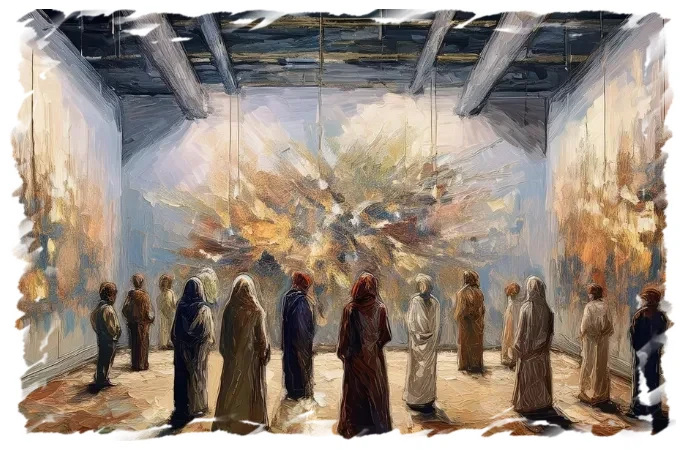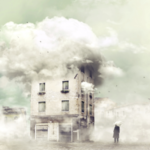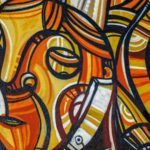Art exhibitions specifically designed to counter dominant cultural narratives are hard to find, even in a country as democratic as India. Exhibitions that portray political art in a way that questions authority are often not given spaces in prominent art and cultural institutions. We are far from achieving a utopian world or a just society, but nothing good comes from inaction. Actively claiming spaces and lowering barriers to participation is a necessary effort to advocate against systemic injustices.
But how will we dissent when the state consistently suppresses resistance? How will we hold the government accountable for excesses and inaction on their part? These are some questions I often ask myself. There is always a sense of helplessness when one witnesses injustice meted out to fellow citizens. On the other hand, it is also a source of energy to see people resisting democratically, undeterred by the consequences.
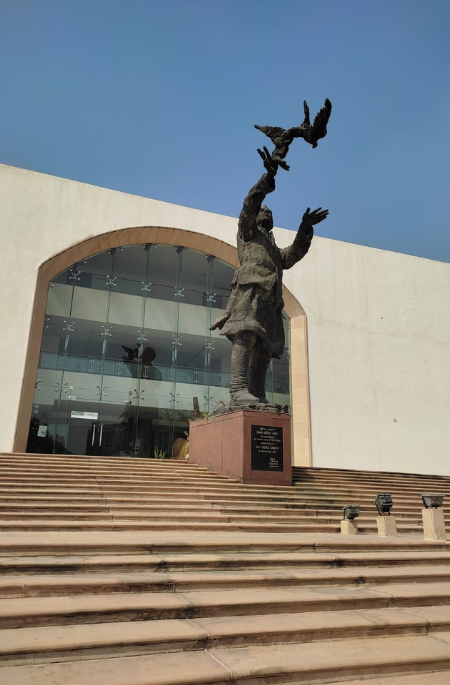
- Jawahar Bhawan, New Delhi
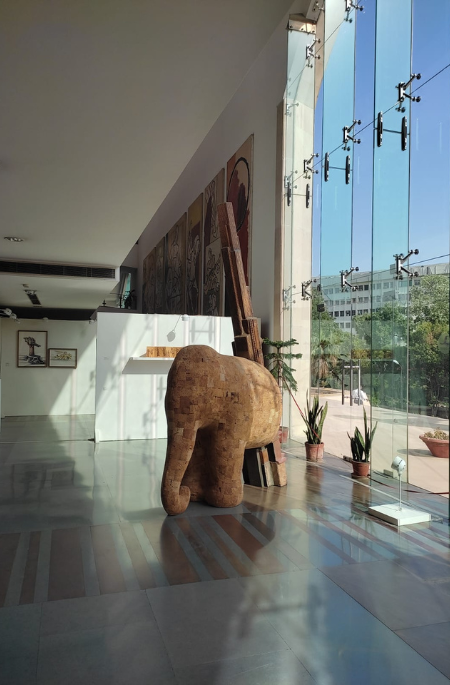
- Arunkumar H G, Overshoot
One such example that enlivened contemporary spaces and forms of dissent is the recently concluded exhibition, ‘Moments in Collapse’ at Jawahar Bhawan, New Delhi (20 April – 20 June 2024). Organised by SAHMAT and curated by noted artist Gigi Scaria, the exhibition brings together conceptual artworks with ‘social, personal and political’ narratives. The space where the artworks were exhibited is well illuminated – the massive glass door and several high windows let in the summer sun. Awash in natural light, the displayed artworks appeared bright and sharp. The artworks were exhibited on temporary wall panels in the lobby area. M.F. Husain’s large-scale artworks adorning background walls added to the exhibition space and theme.
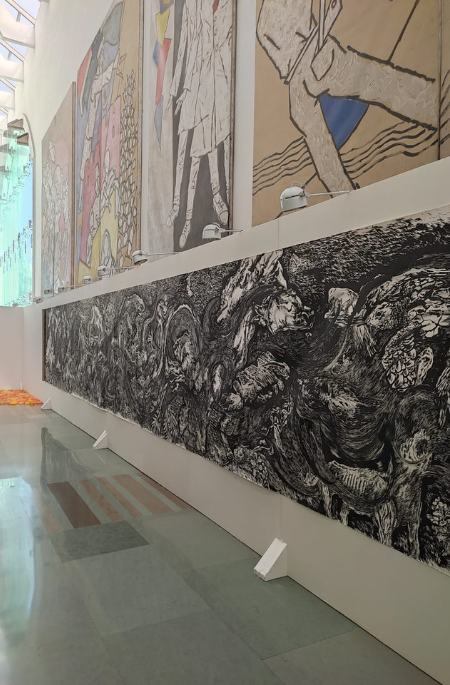
Moments in Collapse covered a wide range of themes that responded to contemporary socio-political issues in the country. The exhibition’s curatorial note adds, “while development is crucial, understanding the nuance of democratic principles within the concept of development is even more crucial.” Labour, civil rights, freedom of expression, and identity, among others, emerged as the prominent themes of the exhibition. Artists have used diverse mediums, from paintings to installations to video art, to convey their ideas best.

4. Parag Sonarghare, Untitled

5. Akshay Sethi, She and the Lathi

- Pushpamala N, Gauri Lankesh’s Urgent Saaru
Parag Sonarghare’s hyper-realistic painting of hands with damaged fingernails depicted workers’ plight. The police attack on students protesting against the CAA-NRC was the subject of Akshay Sethi’s “She and the Lathi”. Pushpamala N’s “Gauri Lankesh’s Urgent Saaru” was a live cooking performance video – a homage to the murdered journalist. Gulammohammed Sheikh’s ink and pastel on paper “Self Besieged” portrayed a maze-like structure where people are stuck in a situation of violence and destruction. Vikrant Bhise’s artwork titled Mahad Satyagraha-2 highlighted the 1927 anti-caste protest in Mahad led by Dr Ambedkar for the right of Dalits to access a public water tank.
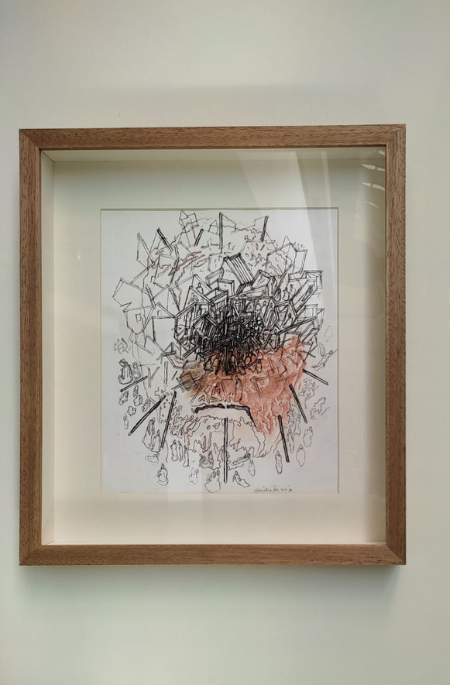
- Gulammohammed Sheikh, Self Besieged
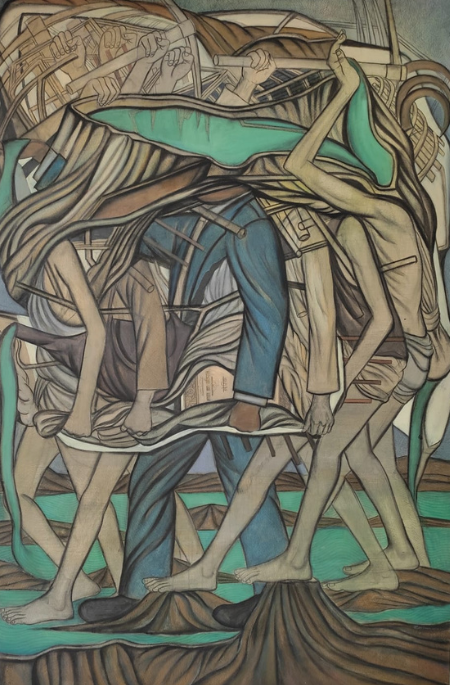
- Vikrant Bhise, Mahad Satyagraha-2
As a young art historian, I often contemplate the role of art in the face of injustice. So, to have encountered an exhibition that explicitly responded to urgent social-political issues reaffirmed the idea of democracy. The exhibition also opened up space for critical reflection on the current political situation.
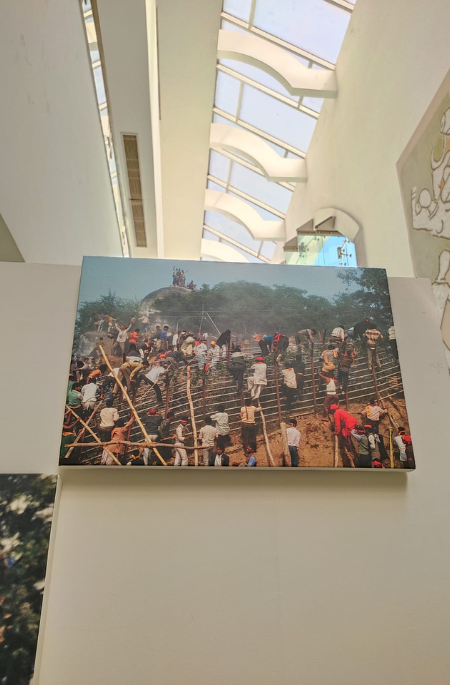
- Pablo Bartholomew, Babri Masjid, post noon 06 Dec. 1992, Ayodhya, Uttar Pradesh, India

- Pablo Bartholomew, The morning after, Babri Masjid, Ayodhya, Uttar Pradesh, India
Pablo Bartholomew’s two photographic works created using pigment ink on canvas, captured the Babri Masjid demolition. The artworks depicted two significant scenes, one where the karsevaks are seen climbing up the fence and some standing atop the mosque’s dome, and the other depicting the next day of the site where they are seen making an effort to destroy every last fragment of the structure altogether. Notably, this work was displayed the same year as the temple’s inauguration at the same site. It points to the fact that art resists attempts at erasing history and memory.
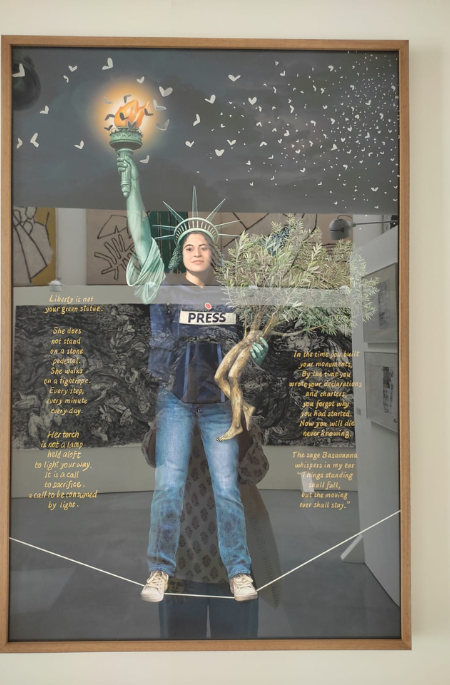
- Orijit Sen, Liberty Is Not Your Green Statue
The prolonged Palestinian struggle for liberation also found a place in the exhibition. It reminded me of a time when India stood strongly in solidarity with the Palestinian people and the joint struggle for peace, equity, and justice of the erstwhile colonised countries in the Global South. Orijit Sen’s digital print artwork ‘Liberty Is Not Your Green Statue’ is a portrait of a well-known Palestinian journalist, Bisan Owda, who has been documenting and sharing every day of her life in Gaza since October 7, 2023, through social media. The artist juxtaposed the famous Statue of Liberty with Bisan’s portrait to question the hypocrisy of the West, which likes to present itself as a moral compass for the world but is actively complicit in physical and structural violence in Asia and Africa.
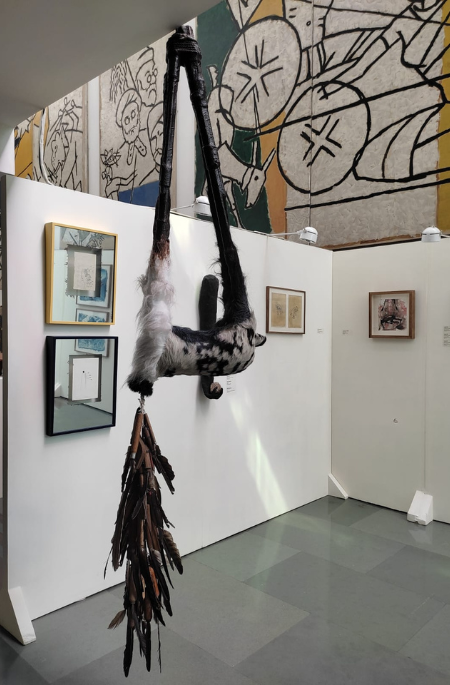
- Niroj Satpathy, Feather Knife
Some works are direct in their depiction and easy to understand, while others are more abstract and require effort. The complexity of such artworks, however, rewards engagement and contemplation. For example, it’s a conceptual work that is both disruptive and engaging. Satpathy assembles waste materials to create his works and to raise awareness about socio-ecological concerns.
In the past few years, the cultural institutions in India have undergone significant changes. The range of ideas, themes, and events has considerably narrowed. While one understands the political impulses to promote ‘Indian culture’, it is also important to recognise that India as a country is diverse and plural; therefore, ideas and expressions vary across its length and breadth. Art and culture are forged in contact, conversation, and exchange. To fit them into a singular political or ideological agenda is at once both reductive and exclusionary.
Moments in Collapse thus was an exhibition that defied the dominant logic of our times. The expansive and sunlit space of Jawahar Bhavan, the stout-hearted curatorial approach, and the diversity of themes and expressions allowed one to breathe freely and feel hopeful.

